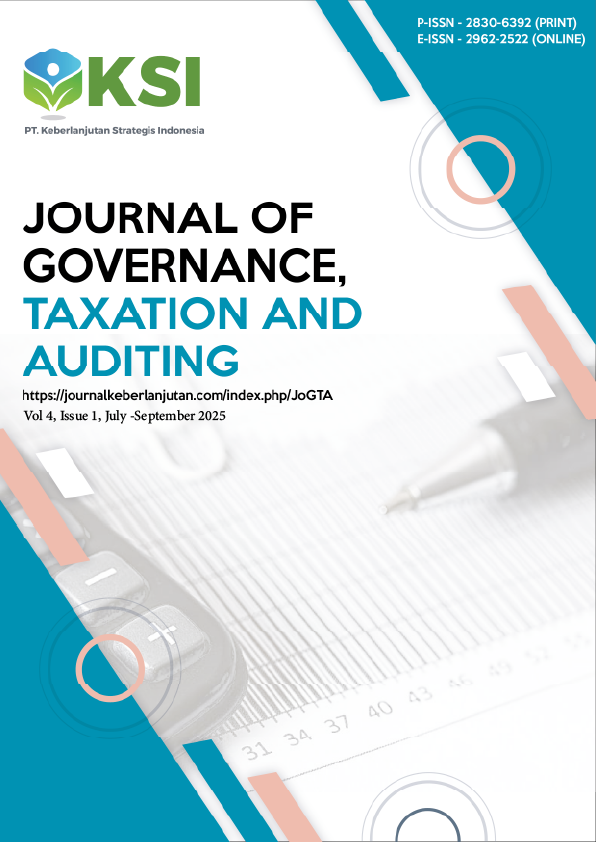Acceptance Analysis of the Core Tax Using the UTAUT Model: A Study on Individual Taxpayers in Palu City
DOI:
https://doi.org/10.38142/jogta.v4i1.1516Keywords:
Coretax Acceptance, UTAUT Model, Behavioral IntentionAbstract
This study aims to analyze the level of acceptance of the Coretax information system from the perspective of individual taxpayers in Palu City. Using the Unified Theory of Acceptance and Use of Technology (UTAUT) model with a final sample of 105 respondents. Data collection was conducted using a questionnaire method, and the results were processed using SPSS version 26 for statistical data analysis. The results of this study indicate that performance expectations and social interactions significantly influence interest in using Core Tax, while effort expectations and facilitating conditions do not significantly influence interest in using Core Tax. The results of this study reinforce the importance of continuously improving the development of tax information systems in Indonesia so that the system can facilitate taxpayers, especially individuals, in fulfilling their tax obligations. As a suggestion for further research, the influence of other variables, such as user habits and hedonic motivations, on the intention to use Coretax can be further studied to complexify the findings of the research on Coretax use.
References
Adi Purwanto, T., & Nofiantoro Program Pendidikan Vo kasi, W. U. (2016). Tingkat Penerimaan Aplikasi Android E-Filing: Analisis dengan Menggunakan Modifikasi Model UTAUT Tingkat Penerimaan Aplikasi Android E-Filing: Analisis Menggunakan Modifikasi Model UTAUT. In NOPEM BER (Vol. 2, Issue 2). https://doi.org/10.32722/multinetics.Vol2.No.2.2016.pp.1-10
Agustini, M. P., Komariah, K., Mulia, F., & Sukabumi, U. M. (2022). Analysis Of Social Interaction, Content Marketing, and Influencer Marketing on Interest in Buying Cosmetic Products (Survey of Dear Me Beauty Consumers in Sukabumi City). Analisis Interaksi Sosial Konten Marketing Dan Influencer Marketing Terhadap Minat Beli Produk Kosmetik (Survey Pada Konsumen Produk Dear Me Beauty di Kota Sukabumi). In Management Studies and Entrepreneurship Journal (Vol. 3, Issue 3). http://journal.yrpipku.com/index.php/msej
Ajzen, I. (1991). The theory of planned behavior. Organizational Behavior and Human Decision Processes, 50(2), 179–211. https://doi.org/10.1016/0749-5978(91)90020-T
Anisa, F., Ananda, F., Tinggi, S., & Kbp, I. E. (2019). Pengaruh Performance Expectancy Terhadap Minat Implementasi Sistem Pengelolaan Keuangan Daerah (SIPKD) di Pemkot Padang. Jurnal Benefita, 4(1), 137–145. https://doi.org/10.22216/jbe.v4i1.3858
Bandura, A. (2001). Social cognitive theory: An agentic perspective. Annual Review of Psychology, 52(1), 1–26. https://doi.org/10.1146/annurev.psych.52.1.1
Brancheau, J. C., & Wetherbe, J. C. (1990). The adoption of spreadsheet software: Testing innovation diffusion theory in the context of end-user computing. Information Systems Research, 1(2), 115–143. https://doi.org/10.1287/isre.1.2.115
Didin Fatihudin, S. E. (2015). Metode penelitian: Untuk ilmu ekonomi, manajemen, dan akuntansi. Zifatama Jawara.
Elsha, N., Atikah, S., & Lenap, I. P. (2022). Pembelajaran Akuntansi Secara Online: Pengujian Model Unified Theory of Acceptance Dan Use of Technology (UTAUT). Balance: Jurnal Akuntansi Dan Manajemen. https://doi.org/10.59086/jam.v1i3.171
Hale, J. L., Householder, B. J., & Greene, K. L. (2002). The theory of reasoned action. The Persuasion Handbook: Developments in Theory and Practice, 14(2002), 259–286. https://doi.org/10.4135/9781412976046.n14
Korat, C., & Munandar, A. (2025). Penerapan Core Tax Administration System (CTAS) Langkah Meningkatkan Kepatuhan Perpajakan di Indonesia. In Jurnal Riset Akuntansi Politala (Vol. 8, Issue 1). http://jra.politala.ac.id/index.php/JRA/index
Lavigne, G. L., Vallerand, R. J., & Miquelon, P. (2007). A motivational model of persistence in science education: A self-determination theory approach. European Journal of Psychology of Education, 22(3), 351–369. https://doi.org/10.1007/BF03173432
Marciano, L. L., Chandra, M. J., & Iskandar, V. (2022). Analisis Penerapan Model Utaut (Unified Theory of Acceptance and Use of Technology) Terhadap Minat Beli Pada Sayurbox. Jurnal Manajemen Perhotelan, 8(2), 80–91. https://doi.org/10.9744/jmhot.8.2.80-91
Miftahul Janna, N., & Pembimbing, D. (n.d.). Konsep Uji Validitas dan Reliabilitas Dengan Menggunakan Spss.
PerPres Nomor 40 Tahun 2018 (2018).
PMK Nomor 81 Tahun 2018 (2024).
Pujihastuti, I. (2010). Prinsip penulisan kuesioner penelitian. CEFARS: Jurnal Agribisnis Dan Pengembangan Wilayah, 2(1), 43–56.
Purnomo, T., Sadiqin, A., & Arvita, R. (2025). Analisis Implementasi Aplikasi Pajak CoreTax dalam Meningkatkan Kepatuhan dan Efisiensi Pelaporan Pajak di Indonesia. Business, Management, Accounting and Social Sciences (JEBMASS), 3(2). http://putrajawa.co.id/ojs/index.php/jebmass
Santi, I. H., & Erdani, B. (2021). Technology Acceptance Model (TAM). Penerbit NEM.
Saragih, A. H., & Septamia, N. U. (2019). Analisis Penerimaan Pengguna E-Filing Menggunakan Model Unified Theory Acceptance and Use of Technology (UTAUT). Jurnal Kajian Akuntansi, 3(1), 1. https://doi.org/10.33603/jka.v3i1.2129
Thompson, R. L., Higgins, C. A., & Howell, J. M. (1991). Personal computing: Toward a conceptual model of utilization. MIS Quarterly, 125–143. https://doi.org/10.2307/249443
Venkatesh, V., Morris, M. G., Davis, G. B., & Davis, F. D. (2003). User acceptance of information technology: Toward a unified view. MIS Quarterly: Management Information Systems, 27(3), 425–478. https://doi.org/10.2307/30036540
Downloads
Published
Issue
Section
License
Copyright (c) 2025 Muhammad RIDWAN, M MASRUDDIN, J JAMALUDDIN, Femilia ZAHRA, E ERWINSYAH

This work is licensed under a Creative Commons Attribution-NonCommercial 4.0 International License.
Creative Commons Attribution-NonCommercial 4.0 International License.





















